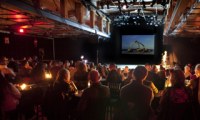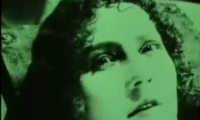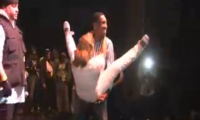Performed on stage by Steven Galloway at Ryeberg Live Vancouver 2013.
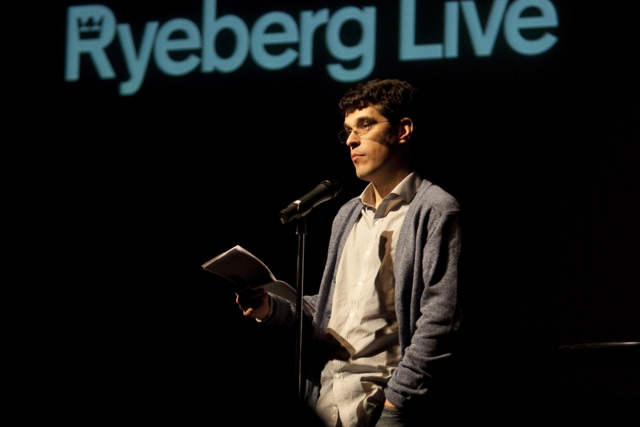
We live in a binary world. One and zero, on and off, right and wrong. We believe what we believe about which is which, and we decamp into groups where each side tries to convince the other side that they are the one. We can, as a society, look at the things that are destroying the world. Certainly there is no shortage, as ever it has been. We argue, and we debate, and we fight about what has been done, what is being done, and what will be done. Everyone believes themselves to be right. It holds as logic that somewhere, someone must be.
But are they? Is anyone ever completely right about anything? What is the point of absolute truths? Nothing, anywhere, is that simple.
Take basic math, for example. We take it as a given that zero plus one is one. And it’s true. If you have zero cupcakes, and I give you a cupcake, then you have one cupcakes. Likewise, if you have one cupcake and you give me one, then you have zero cupcakes. Easy stuff.
Except it’s not that easy. Because as the Greek philosopher Zeno of Elea pointed out in the dichotomy paradox, ironically in support of an idea that is the exact opposite of what I put forth to you tonight, it is impossible to give me a cupcake.
In order to hand that cupcake to me, you must first hand it halfway to me. And before you can hand it halfway to me, you must hand it a quarter of the way to me. And before you can hand it a quarter of the way to me, you must hand it an eighth of the way to me, and so on and so on. Always, before you hand it a portion of the way to me there you must first have handed it half that distance. This dance continues into infinity, as there is always a number that is half the previous number. The problem with as it relates to cupcakes this is time. Each of these tasks takes a unit of time, no matter how small. An infinite number of tasks that take any amount of time can thus never be completed, rendering it impossible for you to give me a cupcake.
So either infinity does not exist, or you cannot give me a cupcake. How, I ask, do we reconcile this? What do we do when choosing sides in the inevitable battle between theoretical physicists and people who have given and received baked goods, each of whom can in their own way prove they are right and the other is wrong?
Every second, the human mind receives 11 million bits of information, about the equivalent of 11 megabites of data, or the amount of space currently required to store “Eleanor Rigby” and a “Hard Day’s Night” on your iPod. That’s every second, assuming you have your eyes and ears and nose and whatever else you use engaged.
The thing is, your conscious mind is only capable of processing about 200 bits a second, 0.2% of your total sensory input. We are constantly engaged in a sort of field general approach to our sensory input, where we are ignoring the overwhelming majority of information available to us in favour of the small amount we deem important in the moment. Sometimes we consciously direct this attention. Right now, for example, you are choosing to listen to me instead of the background noise in the room. You are choosing to look at me instead of the person next to you.
Other times, that attention can be unconsciously influenced. You were not, for example, likely at all aware of the position of your tongue inside your mouth a moment ago. And now you are. (video played without sound)
eChalkIllusion, “The Rotating Mask Illusion” (2012)
This is the hollow face illusion. It is one of the simplest illusions in magic and sensory perception, and one of the most illustrative. It is at once exactly as it appears to be and not at all what it appears to be.
There is no trick photography being employed here. What you are seeing is a concave mask, rotated counter-clockwise. But that’s not what you see, is it?
The processes that make the hollow face illusion work are not unique or unusual. Without them we’d be overwhelmed and unable to cope with our surroundings. But they’re imperfect: even though we know that this mask has a concave side and a convex side and does not possess some kind of magic that gives it a fully rounded human face on both sides, when we see it that is not what our mind attempts to tell us.
Every second of every day, our brains are taking information and contextualizing it in relation to logic, past experience, and current circumstances. It takes unprocessed information and infers structures and processes, and from that derives meaning. This results in much of what arrives in that small part of our minds that is our conscious brain space coming to us pre-packaged, already put into discernable units of sense by the larger machine.
Researchers have observed that individuals with certain mental disorders — un-medicated schizophrenics, for example — and people on LSD and other hallucinogenic drugs are rarely fooled by either the hollow face illusion or other similar optical illusions, likely because their mind’s ability to group, contextualize and categorize information has been compromised.
What’s interesting about this is that in this instance, the brain issue that is preventing what would normally be an effective parsing and presenting of raw information is in fact leading to a truthful conclusion. This is of significance to all of us, not just Timothy Leary and people in tin foil hats.
We assume there is no bias to sensory input, that when you see something with your own eyes it is incontrovertible, and that reason and logic is a path leading us to a quantitative truth.
But of course this isn’t true. And nobody understands that better than magicians.
Mark Wilson, “Dai Vernon Explains The Cup & Balls Trick” (Magic Circus, 1970s)
This is Dai Vernon, one of this century’s greatest slight of hand magicians. He was born in Ottawa in 1894, and was known as both “The Professor” and “The Man Who Fooled Houdini,” after an incident in which he performed a card trick that even the King of Magicians couldn’t dissemble after multiple viewings.
Here Vernon presented for us a fairly standard version of a classic bit, the Cup & Balls. We all saw it, and unless you are particularly observant, ill or stoned, you likely were unable to detect the moments in which you were deceived. To the observer, it appears as though the prestidigitations being presented were genuine.
There are four elements to this grand tug of war between substance and illusion. There is effect, there is method, there is misdirection, and finally, when it’s all over, there is reconstruction. A magician dances between these four elements, seeking to choreograph a way through the trick with these component parts. If he successfully does so, he will have presented magic.
Effect is the reason the trick exists. Without it there’s no point. It’s the rabbit coming out of the hat, the woman shown to be sawn in half, the ace of spades somehow inside your coat pocket. Often a good effect is kept secret up until the moment of its reveal. You don’t actually know what the trick is until it’s finished, and even then while logical and thrilling it’s not what was expected. Other times the effect is announced at the start, and you’re watching for it, waiting for it, but then when it happens you’re still amazed.
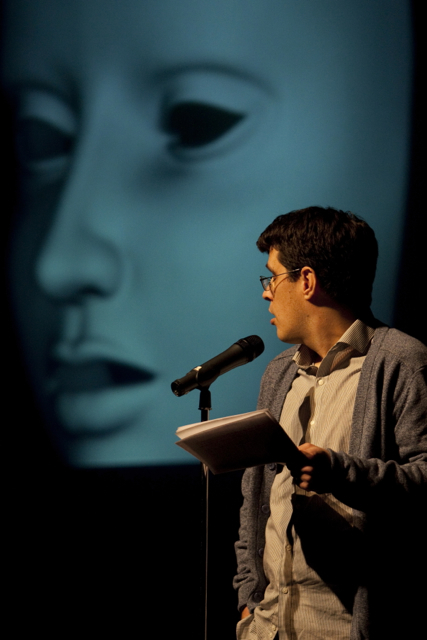 How the magician achieves the effect is called the method. The wires, the doubles, the mirrors, the trapdoors — magical methods vary from deceptively simple to diabolically clever. A good method is one where the element of chance is as neutralized as possible, where as little can go wrong as possible, and where all aspects necessary to create the effect are fully within the magician’s control.
How the magician achieves the effect is called the method. The wires, the doubles, the mirrors, the trapdoors — magical methods vary from deceptively simple to diabolically clever. A good method is one where the element of chance is as neutralized as possible, where as little can go wrong as possible, and where all aspects necessary to create the effect are fully within the magician’s control.
The problem with this is that the audience is on the lookout for the method. Because inherent in the wondrousness of any effect is the implication that if we could do it too, if the method were to become available to us, then we would also be magicians. And who does not secretly want magic powers?
So the audience must never be able to detect the method. If they do the effect will be rendered meaningless. To keep this method secret, the magician employs misdirection. Misdirection can be a subtle as a gesture, as obvious as an explosion, as expected as a curtain, or as coy as smoke. Obviously the audience is on the lookout for this, and the magician must be cunning about his use of misdirection.
The final element, reconstruction, is the most complex. After the effect has been revealed, after the method has been executed and misdirection has prevented its detection, the audience will use their memory to attempt to reconstruct the trick. They will think back to what they saw, and they will try to figure out the method. If they succeed, even after the fact, then the effect is ruined. The misdirection and method must not be identifiable, even in hindsight. For this reason, the magician will insert elements into the trick that are there for the sole purpose of confounding the reconstruction of the trick.
The magician knows that what happened and what we will remember having happened can be two entirely different things. If he shows us A and C, we will believe we saw B, even if this progression violates the laws of physics and nature as we know them. We will swear that we saw the impossible with our own eyes. When we remember events it will be as we believe they happened, not as they actually did.
Let’s look again at The Professor’s cup and balls, just the end right before the main effect, from when he stands up and begins to “explain” his method. What did you see? There were three silver cups, and before he stood up he showed us that there was a ball under each cup. Then, as he explained how he did it, sort of, he pulled up each cup to reveal a large ball underneath. How, we wondered, did that happen? We were watching him the whole time. Look again.
Mark Wilson, “Dai Vernon: 2nd Part Of Cup & Balls Trick” (Magic Circus, 1970s)
Did you see it? You did. There’s an old chestnut in magic, repeated often by magicians: The hand is quicker than the eye. This is perhaps the greatest piece of misdirection ever employed. The eye is in fact much, much quicker than the hand. If you don’t believe me, try the following later, when the light is better, because obviously in the dark the eye is not quick at all. Curl one hand so that it makes a tube, and place it up against your eye, like a telescope made of your hand. Then flick your finger past the opening as fast as you can. Unless your vision is compromised, you will always see your finger.
So the eye is in fact quicker than the hand. The problem with this, or, if you’re a magician, the beauty of this, is that your eye connects to your brain. When a magician combines misdirection and alters reconstruction in combination with a quick hand, we can be made to see things that weren’t there, and not see things that were. You can’t see what you weren’t looking at, and you can’t remember what you didn’t notice.
Let’s look at Mr. Vernon again. We have him with the three balls underneath the cups. (stop at ten seconds)
Mark Wilson, “Dai Vernon: 2nd Part Of Cup & Balls Trick” (Magic Circus, 1970s)
He puts the ball in his back pocket. This is no big deal, and does not seem like misdirection, because he is telling us he’s putting the ball in his pocket. He isn’t, though, and he tells us in a moment that he isn’t. His explanation is misdirection. Let’s look again. (stop at 20 seconds)
Mark Wilson, “Dai Vernon: 2nd Part Of Cup & Balls Trick” (Magic Circus, 1970s)
At this point, he has retrieved from his back pocket, which, when you think about what he’s wearing and the size of the small balls, an odd place to put them, one of the large red balls. He is currently loading it into the left cup. We are distracted, because we’re more interested in his promised explanation of the previous trick, and not suspicious about these movements because he’s made them part of a pattern we are now used to. We’ll watch this again — keep an eye on his hands. (stop at 43 seconds)
Mark Wilson, “Dai Vernon: 2nd Part Of Cup & Balls Trick” (Magic Circus, 1970s)
While he was explaining to us what misdirection was, he loaded the right cup, and then when he was purporting to honestly put the small balls in his pocket he retrieved the ball for the middle cup, and loaded it when he showed the three small balls, which he’d earlier palmed instead of placing them in his pocket. We have, with beautiful simplicity, been misdirected by an admission of misdirection.
At this point, the three large balls are under the cups. We’re all set. We’re still waiting for the trick, but we’re not going to see anything. There’s only one bit of magic left, and that’s the fourth ball. See if you can spot the load and the switch. (from 43 seconds to end)
Mark Wilson, “Dai Vernon: 2nd Part Of Cup & Balls Trick” (Magic Circus, 1970s)
Did you see it? It happened when he was revealing the white ball – there’s a reason that ball is white, and that’s to provide a momentary pattern disruption that removes focus from the fact that he’s reloading the cup. Let’s watch that whole sequence again, now that you know what he’s up to. (full video)
Mark Wilson, “Dai Vernon: 2nd Part Of Cup & Balls Trick” (Magic Circus, 1970s)
The magician is not manipulating us so much as he is exploiting us. Misdirection takes advantage of the fact that we can only consciously process those 200 bites of information every second, and when he uses this misdirection to alter our reconstruction he limits our ability to decode the false connections our unconscious mind created.
We knew whole time that Dai Vernon was not an actual wizard. In a strange way it would be almost disappointing if he genuinely possessed magical powers that altered the known laws of the universe. A complete reordering of the laws of humankind and physics are not what I’m looking for in my entertainment.
But with a binary worldview, my choices are that either he is a wizard or he presented no magic. I propose that both of these things are true, and that neither of them are true, and that any attempt to pick one over the other diminishes both. It is simply not necessary for everything to boil down to right or wrong. It’s a dead end.
It’s a dead end when we apply this binary thinking beyond the metaphor of magic as well. No complex question has two sides. We are not with you or against you, and the world is not dividable into good and evil, right and wrong, or any other trite dichotomy. But neither will a rejection of the ideas of right and wrong or good and evil and the rest get us anywhere either.
It’s a complicated feeling, because the world is complicated. To me, it feels like this.
Yann Frisch, “Mesmerising Sleight of Hand Trick” (2012)
If there is a world where wizards walk among us performing for our amusement, where magic isn’t real, where people on LSD are the only ones who aren’t being fooled, where no one can give me a cupcake and where the infinite is an illusion, well, I don’t want to be a part of it. I want to be a part of it.
– Steven Galloway
